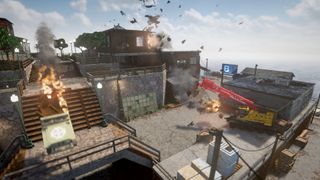Teardown dev on the 'frustrating experience' of developing the breakout hit
"Gameplay was designed to fit the technology, rather than the other way around."

Teardown developer Dennis Gustafsson has written some design notes about the making of one of the year's surprise hits (here's our thoughts). If I was to sum up Teardown it would probably be as long stretches of precision planning, followed by intense and fast destruction: it's a game that offers enormous freedom, but at the same time focuses the player's eye.
"Teardown started as a technology experiment and it’s one of those games where gameplay was designed to fit the technology, rather than the other way around," writes Gustafsson. "It’s not the first time I’ve been involved in such projects (Sprinkle, Smash Hit), and probably not the last, but Teardown was by far the most frustrating experience yet."
Gustafsson goes on to outline the specific challenges of keeping destruction at the core of the game, and setting limits on it while leaving a huge amount of choice in the hands of players. Eventually this led to the game's current 'heist' structure. "After nearly a full year of experimentation and many failed prototypes, the idea of a two-phase heist setting was born. It’s compatible with all the limitations (or lack thereof) that a fully destructible environment impose, while still offering an interesting challenge. It allows the player to move around freely in a fully accessible environment, carefully planning the heist and creating shortcuts using destruction, vehicles and objects from the environment in a creative way."
It was also interesting to find out where Gustafsson believes the game achieves this, and where it's maybe a little too baggy. "Villa Gordon is currently the largest level in the game, and it can already be a bit tedious to walk around during the preparation phase. Personally I think the game shines in a more compact and cluttered environment like Hollowrock Island, with some verticality to allow for more interesting shortcuts."
The full post-mortem is well worth a read for any fan of the game, and goes on to discuss how ideas like timers, trial-and-error gameplay, replayability, story ("Let’s be honest - no one plays Teardown for the story, but I think it serves an important role to frame the missions and as an incentive"), and the general idea of progession in a sandbox game.
PC Gamer Newsletter
Sign up to get the best content of the week, and great gaming deals, as picked by the editors.
Rich is a games journalist with 15 years' experience, beginning his career on Edge magazine before working for a wide range of outlets, including Ars Technica, Eurogamer, GamesRadar+, Gamespot, the Guardian, IGN, the New Statesman, Polygon, and Vice. He was the editor of Kotaku UK, the UK arm of Kotaku, for three years before joining PC Gamer. He is the author of a Brief History of Video Games, a full history of the medium, which the Midwest Book Review described as "[a] must-read for serious minded game historians and curious video game connoisseurs alike."
Most Popular




